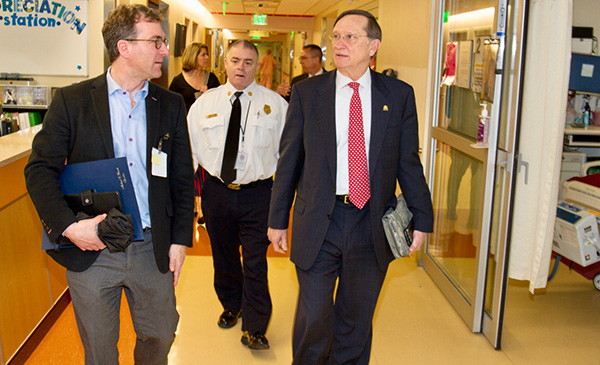Early this week, I had the opportunity to discuss with colleagues at the University of Maryland Medical Center-Shock Trauma the concept of a regional disaster health response system that is capable of responding more effectively and efficiently to the ever-increasing array of 21st century health security threats.

As the last several years have shown, the threat environment is more complex than ever – from infectious diseases with the potential to cause a pandemic, such as the H7N9 influenza virus, to state and non-state actors that have shown an interest in and willingness to use chemical, biological, radiological, or nuclear (CBRN) weapons, to cyber threats and severe weather. Building readiness and response capacity for these threats is my main priority and the catalyst for creating a regional disaster health response system.
The new framework would be built on a tiered regional system that emphasizes the use of local healthcare coalitions and trauma centers that integrate their medical response capabilities with federal facilities and local emergency medical services. This system would expand specialty care expertise in trauma and CBRN casualty management and coordinate medical response through mutual aid. A regional disaster health response system also would incentivize the healthcare system to integrate measures of preparedness into daily standards of care.
Coalitions are the foundation of our disaster health response system. The regional healthcare coalitions created through ASPR’s Hospital Preparedness Program (HPP) are maturing (read Responding to Harvey: How a Houston-area Healthcare Coalition Modeled Success). Their work must not only continue but expand to include additional public and private sector partners (i.e., trauma centers, burn centers, pediatric hospitals, public health labs, and outpatient services).
Coalition partners help to ensure states are better prepared for an emergency by having in place the necessary guidelines and agreements for identifying who is doing what, when, and with what resources (equipment and personnel). But being prepared is only part of the disaster response equation. States and territories also need to be ready to respond quickly and efficiently. Real-time, real-world training is needed for all types of disasters, including CBRN tragedies. A standardized list of indicators must be identified and utilized to determine readiness for each disaster type.
Being ready for a disaster also entails the ability to handle medical surge capacity within a healthcare system. Currently, on any given day, our medical systems perform at near capacity. Mutual aid agreements need to be in place to quickly mobilize physicians and health practitioners from other states when needed without the bureaucratic frustrations and legal risks associated with medical licensing and liability issues.
ASPR is also looking at innovative approaches to incentivize healthcare preparedness. We look forward to continuing the dialogue with our state and local health system partners to explore various avenues to fund this system.
A regional disaster health response system will not happen overnight. Funding to support our nation’s healthcare readiness has declined steadily since 2005. Our healthcare system is largely privately run making it more difficult to get key players to agree to share resources for the benefit of the greater good. Part of my responsibility is to find ways to maximize the use of the available funds and to identify how to use them most effectively. My staff is also committed to developing a business case for readiness that will help competing organizations to work cooperatively. Coalitions are one way to bring together diverse and often competitive healthcare organizations with differing priorities and objectives.
Another step we are taking to help ASPR realize its new vision is to encourage every state and territory to adopt legislation, such as the Uniform Emergency Volunteer Health Practitioners Act  , which allows any medical licensed volunteer to easily cross jurisdictional boundaries in an emergency.
, which allows any medical licensed volunteer to easily cross jurisdictional boundaries in an emergency.
The regional disaster health response system I propose will not replace the assistance HHS now provides through the National Response Framework and the National Disaster Recovery Framework. As HHS’ lead federal agency for Emergency Support Function #8, ASPR will continue to provide medical surge capacity and capability to support state, tribal, and jurisdictional response and recovery efforts. In fact, we have already begun the process of modernizing our Disaster Medical Assistance Teams, redefining their missions, who is part of their teams, how they do patient transport, and how they integrate with hospitals in providing definitive care.
Our regional staff will continue to work closely with state health and emergency management offices. In addition to managing HPP and providing grantees technical assistance through ASPR TRACIE, ASPR will continue to seek better ways to engage public and private partners in developing innovative solutions to the emerging threats of the 21st century.

